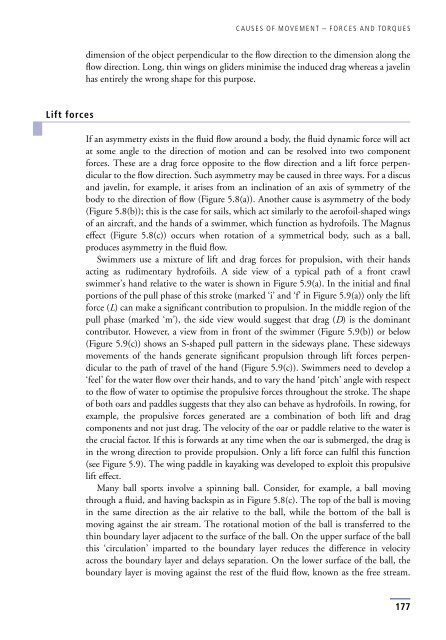Introduction to Sports Biomechanics: Analysing Human Movement ...
Introduction to Sports Biomechanics: Analysing Human Movement ...
Introduction to Sports Biomechanics: Analysing Human Movement ...
You also want an ePaper? Increase the reach of your titles
YUMPU automatically turns print PDFs into web optimized ePapers that Google loves.
Lift forces<br />
CAUSES OF MOVEMENT – FORCES AND TORQUES<br />
dimension of the object perpendicular <strong>to</strong> the flow direction <strong>to</strong> the dimension along the<br />
flow direction. Long, thin wings on gliders minimise the induced drag whereas a javelin<br />
has entirely the wrong shape for this purpose.<br />
If an asymmetry exists in the fluid flow around a body, the fluid dynamic force will act<br />
at some angle <strong>to</strong> the direction of motion and can be resolved in<strong>to</strong> two component<br />
forces. These are a drag force opposite <strong>to</strong> the flow direction and a lift force perpendicular<br />
<strong>to</strong> the flow direction. Such asymmetry may be caused in three ways. For a discus<br />
and javelin, for example, it arises from an inclination of an axis of symmetry of the<br />
body <strong>to</strong> the direction of flow (Figure 5.8(a)). Another cause is asymmetry of the body<br />
(Figure 5.8(b)); this is the case for sails, which act similarly <strong>to</strong> the aerofoil-shaped wings<br />
of an aircraft, and the hands of a swimmer, which function as hydrofoils. The Magnus<br />
effect (Figure 5.8(c)) occurs when rotation of a symmetrical body, such as a ball,<br />
produces asymmetry in the fluid flow.<br />
Swimmers use a mixture of lift and drag forces for propulsion, with their hands<br />
acting as rudimentary hydrofoils. A side view of a typical path of a front crawl<br />
swimmer’s hand relative <strong>to</strong> the water is shown in Figure 5.9(a). In the initial and final<br />
portions of the pull phase of this stroke (marked ‘i’ and ‘f’ in Figure 5.9(a)) only the lift<br />
force (L) can make a significant contribution <strong>to</strong> propulsion. In the middle region of the<br />
pull phase (marked ‘m’), the side view would suggest that drag (D) is the dominant<br />
contribu<strong>to</strong>r. However, a view from in front of the swimmer (Figure 5.9(b)) or below<br />
(Figure 5.9(c)) shows an S-shaped pull pattern in the sideways plane. These sideways<br />
movements of the hands generate significant propulsion through lift forces perpendicular<br />
<strong>to</strong> the path of travel of the hand (Figure 5.9(c)). Swimmers need <strong>to</strong> develop a<br />
‘feel’ for the water flow over their hands, and <strong>to</strong> vary the hand ‘pitch’ angle with respect<br />
<strong>to</strong> the flow of water <strong>to</strong> optimise the propulsive forces throughout the stroke. The shape<br />
of both oars and paddles suggests that they also can behave as hydrofoils. In rowing, for<br />
example, the propulsive forces generated are a combination of both lift and drag<br />
components and not just drag. The velocity of the oar or paddle relative <strong>to</strong> the water is<br />
the crucial fac<strong>to</strong>r. If this is forwards at any time when the oar is submerged, the drag is<br />
in the wrong direction <strong>to</strong> provide propulsion. Only a lift force can fulfil this function<br />
(see Figure 5.9). The wing paddle in kayaking was developed <strong>to</strong> exploit this propulsive<br />
lift effect.<br />
Many ball sports involve a spinning ball. Consider, for example, a ball moving<br />
through a fluid, and having backspin as in Figure 5.8(c). The <strong>to</strong>p of the ball is moving<br />
in the same direction as the air relative <strong>to</strong> the ball, while the bot<strong>to</strong>m of the ball is<br />
moving against the air stream. The rotational motion of the ball is transferred <strong>to</strong> the<br />
thin boundary layer adjacent <strong>to</strong> the surface of the ball. On the upper surface of the ball<br />
this ‘circulation’ imparted <strong>to</strong> the boundary layer reduces the difference in velocity<br />
across the boundary layer and delays separation. On the lower surface of the ball, the<br />
boundary layer is moving against the rest of the fluid flow, known as the free stream.<br />
177






